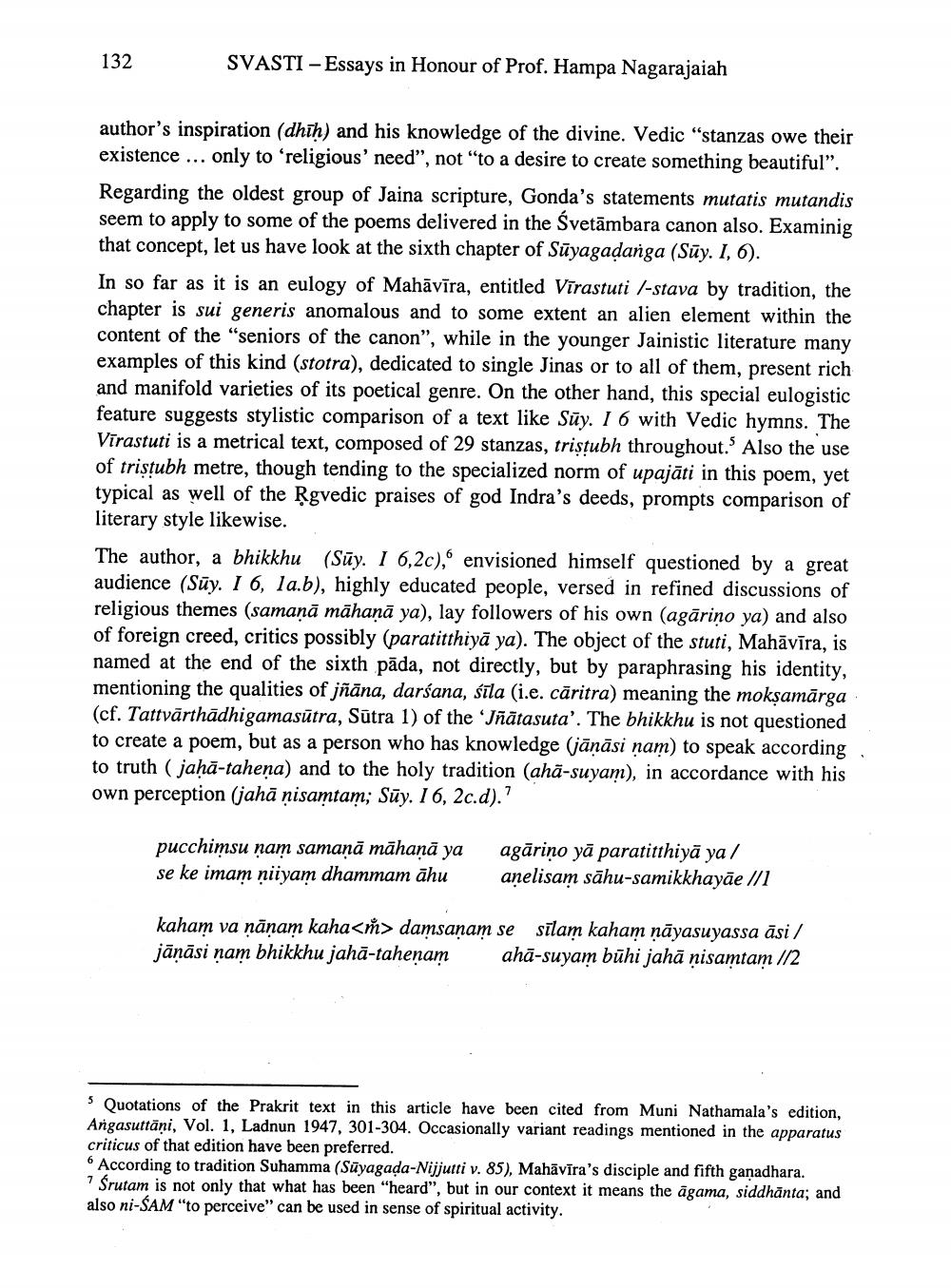________________
132
SVASTI – Essays in Honour of Prof. Hampa Nagarajaiah
author's inspiration (dhīh) and his knowledge of the divine. Vedic “stanzas owe their existence ... only to 'religious' need”, not "to a desire to create something beautiful". Regarding the oldest group of Jaina scripture, Gonda's statements mutatis mutandis seem to apply to some of the poems delivered in the Svetāmbara canon also. Examinig that concept, let us have look at the sixth chapter of Sūyagadanga (Sūy. I, 6). In so far as it is an eulogy of Mahāvīra, entitled Virastuti /-stava by tradition, the chapter is sui generis anomalous and to some extent an alien element within the content of the "seniors of the canon", while in the younger Jainistic literature many examples of this kind (stotra), dedicated to single Jinas or to all of them, present rich and manifold varieties of its poetical genre. On the other hand, this special eulogistic feature suggests stylistic comparison of a text like Suy. I 6 with Vedic hymns. The Vīrastuti is a metrical text, composed of 29 stanzas, tristubh throughout. Also the use of tristubh metre, though tending to the specialized norm of upajāti in this poem, yet typical as well of the Rgvedic praises of god Indra's deeds, prompts comparison of literary style likewise. The author, a bhikkhu (Sūy. I 6,2c), envisioned himself questioned by a great audience (Sūy. I 6, la.b), highly educated people, versed in refined discussions of religious themes (samanā māhanā ya), lay followers of his own (agārino ya) and also of foreign creed, critics possibly (paratitthiyā ya). The object of the stuti, Mahāvīra, is named at the end of the sixth pāda, not directly, but by paraphrasing his identity, mentioning the qualities of jñāna, darśana, śīla (i.e. cāritra) meaning the mokşamārga (cf. Tattvārthādhigamasutra, Sūtra 1) of the Jñātasuta'. The bhikkhu is not questioned to create a poem, but as a person who has knowledge (jāņāsi nam) to speak according to truth (jahā-tahena) and to the holy tradition (ahā-suyam), in accordance with his own perception (jahā ņisamtam; Sūy. 16, 2c.d).'
pucchimsu nam samaņā māhanā ya se ke imam niiyam dhammam āhu
agāriņo yā paratitthiyā ya/ anelisam sāhu-samikkhayāe //1
kaham va nānam kaha<ň> damsanam se sīlam kaham ņāyasuyassa āsi / jānāsi nam bhikkhu jahā-tahenam ahā-suyam būhi jahā nisamtam 1/2
he praktun 194 referredada-Nigh, but i
5 Quotations of the Prakrit text in this article have been cited from Muni Nathamala's edition, Angasuttāņi, Vol. 1, Ladnun 1947, 301-304. Occasionally variant readings mentioned in the apparatus criticus of that edition have been preferred. 6 According to tradition Suhamma (Süyagada-Nijjutti v. 85), Mahāvīra's disciple and fifth ganadhara.
Srutam is not only that what has been "heard", but in our context it means the āgama, siddhānta; and also ni-SAM"to perceive" can be used in sense of spiritual activity.




